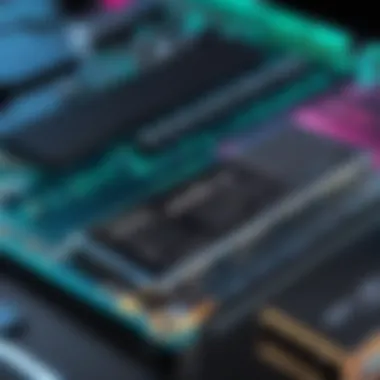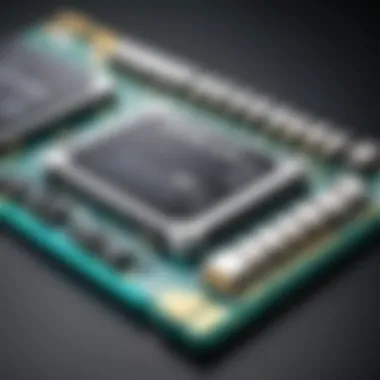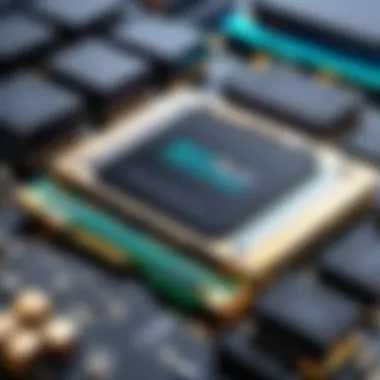Explore NVMe SSDs: Architecture, Benefits, and Trends


Intro
In the fast-evolving world of computer hardware, NVMe SSDs represent a significant leap forward in storage technology. This article aims to provide a comprehensive overview of NVMe (Non-Volatile Memory Express) SSDs, discussing how they can revolutionize a user's experience on a personal computer. The focus will be on performance, compatibility, and the steps necessary for a seamless integration of NVMe SSDs into existing setups.
Product Overview
Key Features
NVMe SSDs are distinct from traditional storage solutions, offering remarkable speed and efficiency. They feature:
- Faster Data Transfer Rates: NVMe drives can reach speeds up to 7000 MB/s, vastly outperforming SATA SSDs and HDDs.
- Low Latency: The architecture allows for concurrent data requests, reducing latency significantly.
- Improved Energy Efficiency: These drives consume less power during operation while providing higher performance.
Technical Specifications
When evaluating NVMe SSDs, certain specifications are essential:
- Form Factor: Common types include M.2 and U.2, with M.2 being more popular for consumer hardware.
- Interface: PCIe 3.0 and PCIe 4.0 are common interfaces with PCIe 4.0 offering better speeds.
- Capacity: NVMe SSDs are available in various sizes, typically ranging from 256 GB to 4 TB or more.
Pricing Information
Pricing can fluctuate based on brand, specifications, and performance. As of recent data, entry-level NVMe SSDs start around $40, while high-performance models can reach upwards of $400. It's essential to compare brands and specifications to get the best value for your needs.
Performance Analysis
Benchmark Results
Standard benchmarks show a clear performance divide. NVMe SSDs consistently deliver higher read and write speeds compared to SATA SSDs. Typical benchmarks report:
- Sequential Read Speed: Up to 7000 MB/s for PCIe 4.0 NVMe.
- Sequential Write Speed: Reaching about 5000 MB/s for high-end models.
Real-World Use Cases
The impact of NVMe SSDs can be seen in various applications, including:
- Gaming: Faster load times lead to a smoother gaming experience.
- Content Creation: Large files can be handled efficiently, enhancing productivity in tasks such as video editing.
- General Use: Day-to-day operations, like booting the OS and launching applications, become notably faster.
Comparison with Competitors
Compared to traditional SATA SSDs and HDDs, NVMe drives outperform them significantly. The difference can be stark:
- SATA SSDs: Maximum read speeds around 600 MB/s.
- HDDs: Maximum read speeds usually below 200 MB/s, leading to potential bottlenecks in modern systems.
Installation and Setup
Required Tools and Components
To set up an NVMe SSD, you will need:
- Compatible Motherboard: Ensure your PC supports NVMe drives.
- Screwdriver: For securing the drive.
- Thermal Pads: Optional, but recommended for optimal cooling.
Step-by-Step Installation Guide
- Power Down the PC: Ensure all power is turned off and unplugged.
- Open the Case: Remove the side panel of your computer case.
- Locate M.2 Slot: Find the M.2 slot on your motherboard.
- Insert the SSD: Place the SSD at an angle and secure it with a screw.
- Close the Case and Power Up: Replace the side panel and start your computer.
- Format the Drive: Use disk management tools to format the new SSD.
Troubleshooting Common Issues
If you encounter issues post-installation, consider the following solutions:
- Drive Not Detected: Check connections and ensure the motherboard supports NVMe.
- Slow Performance: Verify that the drive is correctly initialized and formatted.
Pros and Cons
Advantages of the Product
- Speed: The most significant advantage is the superior speed in data transfer.
- Efficiency: Improved energy usage and cooling dynamics enhance longevity.
Disadvantages or Limitations
- Cost: NVMe SSDs tend to be more expensive than their SATA counterparts.
- Heat: Higher performance often leads to increased heat generation, requiring good case ventilation.
Who It’s Best Suited For
NVMe SSDs appeal to tech enthusiasts, gamers, and professionals who require rapid data access and enhanced performance.
Final Thoughts
Summary of Key Points


NVMe SSDs represent a significant advancement in storage technology, delivering remarkable speed and efficiency. Their architecture eliminates many bottlenecks present in older systems, making them a valuable upgrade.
Recommendations for Potential Buyers
Evaluate your needs and budget. If you engage in gaming, content creation, or require fast system performance, investing in an NVMe SSD is worthwhile.
Future of the Technology or Product Line
Looking ahead, advancements in NVMe technology promise ever-increasing speeds and capacities, making it a staple in future computing landscapes. Innovations like PCIe 5.0 are already on the horizon, setting the stage for even more robust performance.
Preface to NVMe SSDs
In the rapidly evolving landscape of computer hardware, NVMe SSDs (Non-Volatile Memory Express Solid State Drives) represent a significant leap forward. These drives offer faster data transfer rates, reduced latency, and overall improved performance compared to traditional storage solutions. Understanding NVMe SSDs is essential for anyone interested in optimizing their computing experience, whether for gaming, professional tasks, or general use.
Definition and Overview
NVMe SSDs are designed with modern architectures in mind. Unlike previous storage solutions, NVMe utilizes the PCIe (Peripheral Component Interconnect Express) interface. This allows for higher data throughput and lower latency. The drive operates by sending commands directly to the flash memory, enabling superior performance. Not only do these drives access data faster, but they also handle multiple data requests simultaneously, which is crucial for high-performance computing tasks.
Key features of NVMe SSDs include:
- Speed: NVMe drives significantly outperform SATA drives in terms of read and write speeds.
- Efficiency: They consume less power while delivering higher performance.
- Scalability: NVMe technology is adaptable, allowing for enhancements as newer protocols emerge.
As personal computing demands increase, the relevance of NVMe SSDs becomes clearer. They provide the necessary speed for applications that require fast data access, such as video editing and gaming.
Evolution from SATA to NVMe
The transition from SATA (Serial ATA) to NVMe SSDs illustrates a trend toward maximizing performance. SATA, developed in the early 2000s, was bound by its limitations, including lower data transfer rates and increased latency. On the other hand, NVMe was designed to address these shortcomings.
This evolution can be summed up in a few key points:
- Increased Bandwidth: SATA III offers a maximum throughput of 6 Gbps, whereas NVMe can achieve speeds exceeding 32 Gbps.
- Lower Latency: The command queue of NVMe allows for thousands of simultaneous requests, while SATA is limited to a few.
- Direct Connection: NVMe connects directly to the motherboard, ensuring lower response times.
NVMe technology represents a fundamental shift in how storage devices interact with the operating system, providing a framework for future advancements in data storage.
In summary, the move from SATA to NVMe SSDs highlights the shift toward performance-centric technology in personal computing. Understanding this transition allows users to make informed choices when upgrading their systems.
Architecture of NVMe SSDs
The architecture of NVMe SSDs is a crucial aspect of understanding their functionality and efficiency in personal computing. This architecture greatly influences the performance, speed, and responsiveness of the solid-state drives that have become predominant in modern systems. By examining the intricate design and components of NVMe SSDs, users can appreciate the leap in technology over traditional storage methods.
Data Transmission Protocol
NVMe, or Non-Volatile Memory Express, serves as the protocol that facilitates communication between the SSD and the computer’s motherboard. It is designed specifically for flash memory. This protocol improves the speed and performance of data transfers compared to older protocols like SATA. NVMe uses a parallel processing approach, which allows multiple commands to be executed simultaneously. This capability leads to significantly reduced latency and increased throughput.
In practical terms, users notice this improvement during high-demand tasks, such as loading games or processing large files. The effective use of the PCIe interface further enhances these benefits, making it possible for NVMe SSDs to achieve much faster read and write speeds, often multiples of what SATA SSDs can provide. This progress translates to faster boot times and smoother application performance.
Internal Structure
The internal structure of NVMe SSDs consists primarily of two key components: the controller and flash memory types.
Controller
The controller acts as the brain of the NVMe SSD. It manages data flow between the storage and the system, deciding how information is stored, retrieved, and processed. One key characteristic of the controller is its ability to handle multiple data transfers at once, a feature made possible by the NVMe protocol.
This multidimensional processing capability is a significant benefit. It allows the controller to optimize data management, minimizing wait times for users. A specific unique feature of many controllers is the inclusion of DRAM cache. This cache enhances performance by storing frequently accessed data for rapid retrieval, aiding in high-speed operations. However, it is worth noting that controllers without DRAM cache may experience slower performance under certain conditions.
Flash Memory Types
Flash memory types represent another critical aspect of NVMe architecture. Different types, such as SLC (Single-Level Cell), MLC (Multi-Level Cell), TLC (Triple-Level Cell), and QLC (Quad-Level Cell), offer varied benefits and drawbacks. The key characteristic of these types relates to their storage density and speed. For example, SLC generally provides the fastest speeds and durability but at a higher cost and lower storage capacity.
In contrast, QLC offers higher storage densities at a lower cost, but it sacrifices some speed and longevity. The unique feature of each flash memory type determines its suitability for specific applications. For instance, gamers might prefer SSDs with MLC or TLC for a balance of speed and capacity. Understanding these considerations will aid users in making informed choices about which NVMe SSD best meets their needs.
In summary, the architecture of NVMe SSDs influences their efficiency and performance. The combination of an advanced data transmission protocol, a robust controller, and various flash memory types all contribute to the overall functionality of NVMe SSDs, making them a superior choice for modern computing environments.
Performance Advantages of NVMe SSDs
NVMe SSDs have revolutionized storage technology for PC users, providing significant enhancements over traditional storage options. The benefits stem primarily from their architecture and the efficient use of the PCIe interface. This section will detail these advantages by examining specific elements like speed metrics and real-world performance improvements.
Speed Metrics
Read and Write Speeds
Read and write speeds in NVMe SSDs are notably high. These speeds can reach up to 7,000 MB/s for reading and 5,000 MB/s for writing, depending on the model. Such rates drastically reduce loading times for applications and files.
In this article, the focus is on how the impressive read and write speeds contribute to a smoother user experience. Users can load large files, such as games or high-resolution videos, quicker than with traditional SATA SSDs.
One unique aspect is the parallel data processing capability of NVMe SSDs. Unlike SATA, which processes data sequentially, NVMe can handle multiple queues and commands at once. This feature is advantageous, especially for gamers and professionals who work with large data sets or handle multiple tasks simultaneously.
Latency Reduction


Latency is a critical factor in storage performance. NVMe SSDs offer lower latency than previous technologies. The reduced latency leads to faster response times when accessing data. This characteristic is important for tasks requiring real-time processing, such as online gaming or data analytics.
The NVMe protocol eliminates many of the overheads associated with older interfaces. This means less waiting time for data requests to be fulfilled. The unique feature of low latency allows NVMe SSDs to respond swiftly to read and write commands, enhancing overall system responsiveness.
Real-world Performance Improvements
Boot Times
Boot times are a tangible improvement seen with NVMe SSDs. Users can experience boot times as fast as a few seconds, compared to over thirty seconds for a traditional hard drive. This characteristic makes NVMe SSDs an attractive choice for users wanting a fast, responsive system.
The ability to boot quickly allows users to get to work or play in no time. This is especially beneficial for those who frequently restart their systems or need to switch between various tasks quickly.
Furthermore, the unique feature of fast booting enhances the overall user experience. For power users, the decreased boot time is a considerable advantage, making their workflows more efficient.
Data Transfer Rates
Data transfer rates are crucial when discussing NVMe SSDs. These drives can offer impressive transfer rates, significantly speeding up file transfers. Users can transfer large files or backup data much more swiftly than before.
The characteristic of high data transfer rates is essential for creative professionals such as video editors who often handle large files. The unique feature of consistent performance consistency during heavy workloads ensures that projects experience fewer delays.
Compatibility Considerations
Compatibility is a critical aspect when choosing NVMe SSDs for your PC. Not all motherboards or operating systems support NVMe technology, meaning users must ensure their setup is compatible before purchasing. By understanding these compatibility factors, users can avoid potential issues and maximize performance gains from NVMe SSDs.
Motherboard Compatibility
When selecting an NVMe SSD, the first consideration should be your motherboard. Not every motherboard has an M.2 slot, which is required for NVMe SSD installation. Users must check if their motherboard supports NVMe drives specifically, as SATA drives can also fit into M.2 slots, though they do not take advantage of NVMe speeds.
Factors to Consider:
- M.2 Slot Availability: Confirm that your motherboard has an available M.2 slot.
- Slot Type: M.2 slots come in different types; ensure it supports NVMe (PCIe) buses.
- Physical Size: NVMe SSDs differ in length (2230, 2242, 2260, etc.). It's important to select an SSD that fits the specific slot on your motherboard.
Meeting these requirements will ensure you can install and utilize NVMe SSDs effectively.
Operating System Support
The next major consideration is the operating system used on your PC. Most modern operating systems, including Windows 10 and 11, macOS, and various Linux distributions, support NVMe. However, confirmation of driver support is vital. Not having proper driver support can lead to suboptimal performance or even prevent the drive from being recognized.
Key Considerations:
- Update OS: Keep your operating system updated to ensure all necessary drivers for NVMe SSDs are available.
- Driver Installation: In some cases, users may need to download and install drivers manually. Check the manufacturer's website for specific drivers.
- Compatibility Lists: Many NVMe SSD manufacturers provide compatibility lists for operating systems, which can be helpful for ensuring proper function.
Checking these aspects will enhance your chances of a smooth installation and great performance with NVMe SSDs in your computing setup.
Choosing the Right NVMe SSD
Choosing the right NVMe SSD is critical for enhancing overall computing performance. NVMe SSDs offer different capacities, brands, and features, making it essential to evaluate these aspects before making a decision. A suitable NVMe SSD can boost system responsiveness, improve workflow, and future-proof your setup.
Capacity Considerations
Current Options in the Market
Today, the market is flooded with various NVMe SSDs catering to different storage needs. The most common capacities range from 250 GB to several terabytes. Brands like Samsung, Western Digital, and Crucial present choices that fit diverse requirements. For instance, Samsung 970 EVO with 500 GB is a popular choice, offering great performance for gaming and productivity tasks.
A key characteristic of current options is flexibility. Users can select a drive size that meets their current needs without overspending on larger capacities they may not utilize. However, it's vital to think ahead; what fits today may not suit future demands. The unique advantage here is that users have access to SATA alternatives as well, which can provide cost-effective solutions.
Future-Proofing Your Purchase
When selecting an NVMe SSD, future-proofing plays an essential role. Purchasing a drive with higher capacity than currently needed can save upgrade hassle in the future. The minimum recommended size today would be 1 TB, which is optimal for gaming, extensive media editing, and heavy tasks.
A critical element of future-proofing is price vs. storage growth. As data storage needs grow, it is wise to invest in higher capacity models. Moreover, adopting newer technologies like PCIe 4.0 would be advantageous, given that newer motherboards support this higher bandwidth. While upfront costs may be higher, the long-term benefits often outweigh these.
Brand Comparison
Establishing Brand Trust
Establishing brand trust is essential when selecting an NVMe SSD. Brands such as Samsung, Kingston, and Corsair have built reputations for reliability. Their long-standing presence in the market provides assurance of performance and durability. A reputable brand typically invests in research and development, ensuring their products meet user expectations.
Some brands provide extended warranties or customer support. This conveys reliability and encourages buyers to make informed decisions without fear of malfunction. Trustworthy brands often show consistent performance across their product ranges, making them appealing choices in this article.
Product Review Analysis
Product review analysis is crucial for understanding the performance characteristics of NVMe SSDs. Resources like online tech forums, consumer electronics websites, and customer feedback loops can offer insights into usability. Users often review aspects like real-world performance, thermal management, and longevity.
The practice of examining reviews aids in comparing various models within the same category. A detailed analysis of reviews can highlight strengths and weaknesses of specific SSD models. Often, insights from actual users help new buyers gauge satisfaction levels and determine if a product aligns with their expectations.
Installation and Setup
Installation and setup of NVMe SSDs is a crucial step for optimizing your PC's performance. Proper installation ensures that the system recognizes the device efficiently while correct setup enables maximum speed and reliability. Here, we focus on how to install an NVMe SSD and configure the BIOS settings effectively.


Installation Process
Installing an NVMe SSD can seem daunting, yet it is a straightforward task when approached methodically. Below are key steps to guide you through this process:
- Prepare Your Tools and Workspace: Before starting, have the necessary tools ready. You will typically need a screwdriver and an appropriate anti-static wrist strap to prevent damage from static electricity.
- Turn Off Your PC: Ensure that the computer is powered down completely. Unplug it from the wall socket to avoid any risk of electric shock.
- Open the Computer Case: Use your screwdriver to remove the side panel of your computer case. Many cases have thumb screws, which means no tools are needed.
- Locate the M.2 Slot: NVMe SSDs are installed in M.2 slots, which can vary depending on your motherboard. Refer to your motherboard manual to find the right location.
- Insert the NVMe SSD: Align the notch on the SSD with the key in the M.2 slot. Insert it at about a 30-degree angle. Once in, push down gently and fasten it to the motherboard with the screw provided.
- Reassemble Your PC: After installation, replace the side panel of your case and reconnect any peripherals you detached earlier.
- Power On the System: Start your PC to ensure the SSD is recognized. If successful, the new device should be visible in the storage settings.
Configuring BIOS Settings
Configuring the BIOS after the installation is a vital next step. Proper BIOS settings help ensure that the NVMe SSD operates at optimal performance levels. Here’s how to navigate this:
- Enter BIOS Setup: As your PC boots, continuously press the designated key (usually Del, F2, or Esc) to enter the BIOS setup. Refer to your motherboard documentation if unsure.
- Check Drive Recognition: Upon entering BIOS, navigate to the storage configuration section. Verify whether your new NVMe SSD is listed. If it isn’t, recheck the installation process.
- Change Boot Order: If you plan to install an operating system on the NVMe SSD, you may need to adjust the boot order. Set the NVMe SSD as the primary boot device.
- Enable NVMe Support: Ensure that NVMe support is enabled in the BIOS settings. This option is typically found in the advanced settings menu.
- Save and Exit: After adjusting settings, look for the option to save changes and exit. Your PC will restart with the new configurations.
Proper installation and BIOS configuration of NVMe SSDs can significantly boost your system's performance, making tasks more efficient and responsive.
Being aware of the installation process and BIOS configurations allows effective use of NVMe technology. Readers should now feel sufficiently informed to carry out this essential upgrade to their PCs.
Common Issues and Troubleshooting
Understanding potential issues with NVMe SSDs is crucial for both tech enthusiasts and casual users. While NVMe technology offers impressive speed and efficiency, it is not without its challenges. Addressing common problems can help users maximize the performance and longevity of their drives. This section provides insight into two frequent concerns: performance throttling and data corruption risks.
Performance Throttling
Performance throttling is a common issue that can affect NVMe SSDs, leading to reduced speeds during intensive tasks such as gaming or data transfer. Several factors contribute to this phenomenon. One major reason is thermal management; NVMe SSDs tend to generate a significant amount of heat during operation. If the temperature exceeds optimal levels, the drive may automatically reduce its performance to avoid damage.
Other factors influencing performance throttling include:
- Insufficient cooling solutions: The lack of adequate airflow or cooling mechanisms can exacerbate thermal issues.
- High workloads: Continuous heavy usage can challenge the drive, resulting in lower efficiency.
- Firmware limitations: Outdated firmware may not effectively manage performance, contributing to throttling.
To mitigate performance throttling, consider the following strategies:
- Use a heatsink: Installing a heatsink can help manage temperatures more effectively.
- Monitor temperatures: Regularly check the operating temperatures using software tools. This helps in understanding when throttling might occur.
- Upgrade firmware: Ensure that the firmware is up to date to access performance optimizations from the manufacturer.
Regular maintenance and monitoring can significantly enhance the performance stability of NVMe SSDs.
Data Corruption Risks
Data corruption is another serious concern for NVMe SSD users. Unlike traditional hard drives, SSDs use flash memory that can be susceptible to data integrity issues if not managed properly. Corruption may arise from various sources, including power interruptions, firmware bugs, or sudden system crashes.
Some contributing factors to data corruption include:
- Power loss during writes: An unexpected power loss while data is being written can lead to corruption.
- Firmware vulnerabilities: Bugs in the SSD's firmware can compromise data integrity.
- Wear and tear: Over time, flash memory cells have limited write/erase cycles, increasing the risk of failure and corruption.
To minimize the risk of data corruption:
- Use a reliable power supply: Ensure a stable power source to prevent unexpected shutdowns.
- Regular backups: Maintain backups of important data to safeguard against corruption. Utilizing cloud storage or external drives can offer extra layers of protection.
- Firmware updates: Keep the SSD’s firmware up to date to benefit from fixes and improvements.
Addressing these common issues, such as performance throttling and data corruption risks, empowers users to enhance their experience with NVMe SSDs. By being vigilant and implementing preventative measures, users can mitigate risks and ensure reliable performance.
Future Trends in NVMe Technology
The evolution of NVMe technology is pivotal for enthusiasts and professionals alike. Understanding emerging trends can influence both personal computing and enterprise solutions. Users must stay informed about advancements that can enhance performance, capacity, and applications.
Emerging Standards and Protocols
NVMe technology evolves continuously. New standards aim to enhance interoperability and performance. Key protocols include NVMe over Fabrics (NoF). This allows NVMe devices to communicate over a network, increasing flexibility. With NoF, users can benefit from high-speed data access not limited to local storage. Factors like scalability and future compatibility underline the importance of keeping up with these innovations.
Consider the potential of the NVMe-MI (Management Interface). This standard provides management capabilities for NVMe SSDs, streamlining the monitoring of systems. Such features not only enhance performance but also enable easier diagnostics. As technology continues to grow, ongoing adaptation to new standards is necessary for optimal efficiency.
Expanding Applications
Gaming
Gaming is transforming due to NVMe SSDs. These drives considerably reduce load times. Titles like Call of Duty and Cyberpunk 2077 showcase this improvement. The rapid data transfer speeds allow seamless gameplay and instant access to large game files.
Key characteristics include high read and write speeds. Higher speeds offer players a distinct advantage. In competitive gaming, every millisecond counts. However, not every gamer needs a top-tier version. Value for money should be evaluated against performance.
Data Centers
Data centers utilize NVMe technology for increased efficiency. They handle vast amounts of data, requiring rapid access speeds. The unique feature of NVMe SSDs in this context is parallelism. They can process numerous requests at once, a crucial factor for large-scale operations.
Benefits include reduced latency and improved throughput. As businesses rely more on data-driven solutions, the demand for this technology will expand. Careful consideration of capacity and performance will be necessary for design and scalability in future data centers.
Finale
The conclusion of this article serves as a pivotal recap of the essential aspects surrounding NVMe SSDs. Their significance within the realm of personal computing cannot be overstated. NVMe SSDs provide not only remarkable speed but also a reliability that enhances the overall user experience. This section synthesizes the information discussed throughout the article while emphasizing the key takeaways for PC users aiming to optimize their systems.
Summary of Key Points
- Performance Benefits: NVMe SSDs substantially outperform traditional SATA SSDs in both read and write speeds. This means faster boot times and reduced loading times in applications.
- Compatibility: Choosing the right NVMe SSD requires awareness of motherboard support and operating system compatibility. Ensuring that your hardware can accommodate these drives is essential for peak performance.
- Future Trends: As NVMe technology develops, new protocols and increased capacities are on the horizon, paving the way for even more versatile and powerful applications.
- Installation and Configuration: Correct installation and BIOS settings are critical to unlocking the full potential of NVMe SSDs. Users must pay attention to these areas during setup to avoid common issues.
- Troubleshooting: Understanding the potential for performance throttling and data corruption can aid users in maintaining optimal performance and reliability.
Final Thoughts on NVMe SSDs
In summary, NVMe SSDs represent a significant leap in storage technology. For tech enthusiasts, gamers, and casual consumers alike, the advantages of these drives are clear. They provide not only enhanced speed but also a level of efficiency that is becoming increasingly necessary in modern computing. As storage requirements continue to grow, investing in an NVMe SSD may very well be one of the most impactful upgrades one can make. Thus, knowing how to choose, install, and maintain these devices is critical for any user serious about enhancing their computing experience.
NVMe technology has firmly established itself at the forefront of storage solutions. Understanding its intricacies and benefits will be invaluable for those looking to stay updated with advancements in technology.



